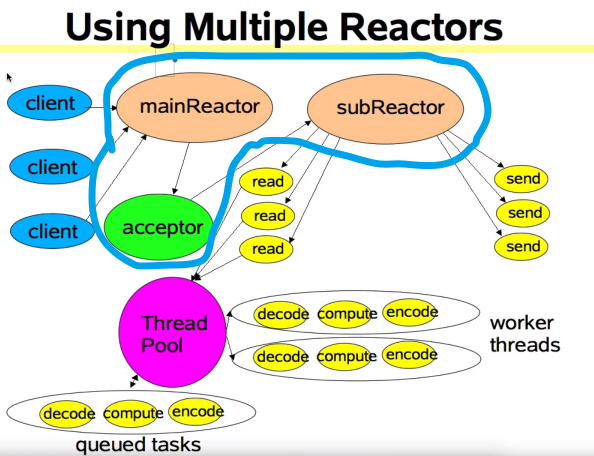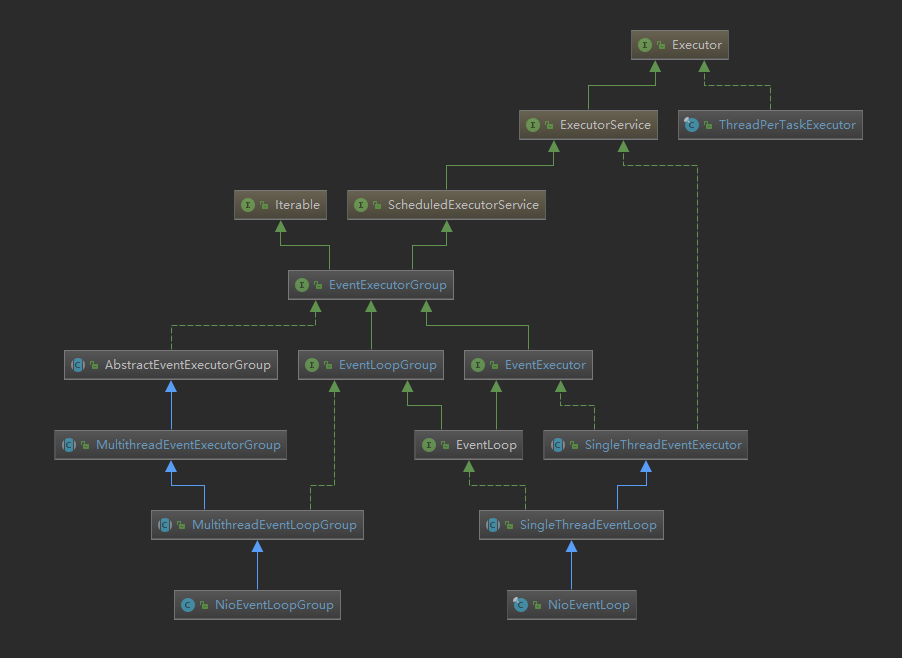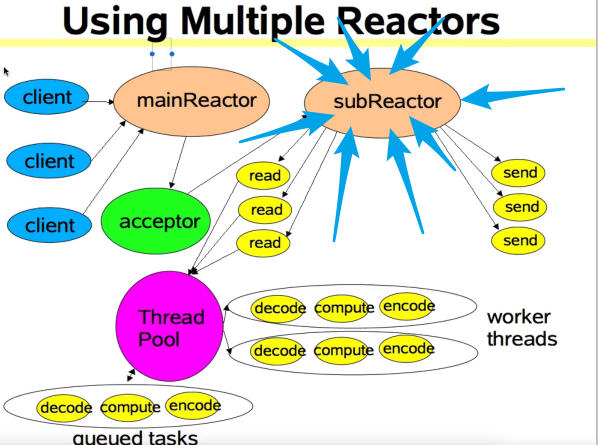什么是新连接接入?以及新连接接入前,Netty处于什么状态
netty的服务端NioServerSocketChannel初始化,注册在BossGroup中的一条NioEventLoop中,并且给NioServerSocketChannel中维护的jdk原生的ServerSocketChannel绑定好了端口后, EventLoop启动,开始轮询工作...
这时候 EventLoop 它在轮询什么? 其实它在轮询监听当初NioServerSocketChannel经过二次注册感兴趣的事件时, 告诉 Selector,让Selector关注自己身上可能会出现 OP_ACCEPT 事件, 这合情合理,因为对于Netty的主从Reactor线程模型中, BossGroup中的channel只关心OP_ACCEPT 也就是用户的请求建立连接事件

netty的新连接接入要做哪些工作?
看上图,netty的新连接接入,对应这个线程模型中我圈出来的部分, 主要步骤如下
- 服务端Selector轮询到客户端请求建立连接
- 处理请求
- 从服务端维护的JDK 原生ServerSocketChannel中accept()客户端的channel
- 使用new的方法 将客户端的Channel封装成 NioSocketChannel
- 层层往上调用super(),初始化channel的组件
- 创建channel的配置类对象 config
- 向下传播channelRead事件
- 给客户端的channel设置相关参数
- 将客户端的channel注册在 workerGroup 中的轮询算法选出的 EventLoop
- 将jdk原生的SocketChanel注册进 EventLoop中的选择器中
- 传播channelregist事件
- 传播channelActive事件
- 给客户端的channel二次注册netty可以处理的感兴趣的事件
这是我总结的新连接接入的流程,从上面分析的开始检查新链接,终止的标志是,把客户端的NioSocketChannel二次注册在EventLoop上,成为Netty可以处理的chanel为止
入口:NioEventLoop处理IO事件
当服务端的事件循环检测到有io事件时,使用它的processSelectedKeys();处理,源码如下:
private void processSelectedKeys() {
// todo selectedKeys 就是经过优化后的keys(底层是数组) , 默认不为null
if (selectedKeys != null) {
processSelectedKeysOptimized();
} else {
processSelectedKeysPlain(selector.selectedKeys());
}
}
当有了新IO请求进来, jdk原生的Selector将SelectionKey放入存放感兴趣的key的集合中,而这个集合现在就是netty通过反射的方式强制替换为以数组为数据结构的selectedKeys, 数组不为空, 跟进processSelectedKeysOptimized();,源码如下: 解析写在源码下面:
private void processSelectedKeysOptimized() {
for (int i = 0; i < selectedKeys.size; ++i) {
final SelectionKey k = selectedKeys.keys[i];
// null out entry in the array to allow to have it GC'ed once the Channel close
// todo 数组输出空项, 从而允许在channel 关闭时对其进行垃圾回收
// See https://github.com/netty/netty/issues/2363
// todo 数组中当前循环对应的keys质空, 这种感兴趣的事件只处理一次就行
selectedKeys.keys[i] = null;
// todo 获取出 attachment,默认情况下就是注册进Selector时,传入的第三个参数 this===> NioServerSocketChannel
// todo 一个Selector中可能被绑定上了成千上万个Channel, 通过K+attachment 的手段, 精确的取出发生指定事件的channel, 进而获取channel中的unsafe类进行下一步处理
final Object a = k.attachment();
// todo
if (a instanceof AbstractNioChannel) {
// todo 进入这个方法, 传进入 感兴趣的key + NioSocketChannel
processSelectedKey(k, (AbstractNioChannel) a);
} else {
@SuppressWarnings("unchecked")
NioTask<SelectableChannel> task = (NioTask<SelectableChannel>) a;
processSelectedKey(k, task);
}
if (needsToSelectAgain) {
// null out entries in the array to allow to have it GC'ed once the Channel close
// See https://github.com/netty/netty/issues/2363
selectedKeys.reset(i + 1);
selectAgain();
i = -1;
}
}
}
处理感兴趣的事件, 想想,需要什么他才能进一步处理呢? 需要下面两点:
- 这个感兴趣的事件是啥?
- 在这了就是上面的 k
- 哪个channel出现的Selector感兴趣的事件?
- 在这里是通过 attachment拿到的 a ,其实不就是服务端的
NioServerSocketChannel?
- 在这里是通过 attachment拿到的 a ,其实不就是服务端的
另外它把NioServerSocketChannel向上强转成了AbstractNioChannel这是为什么呢?
答:
第一点:
在我写的上一篇Chanel的架构体系中,我们知道,Netty的NioXXXChannel其实是netty的,基于原生的jdk的chanel的封装,而在他的整个继承体系中,这个AbstractNioChannel就负责维护jdk原生的channel, 知道了这有啥用? 当然有用,我们要去给客户端channel接生了,原生服务端channel.accept()==客户端channel
第二点:
针对数据的读写都是unsafe中,回想是哪个类中定义了读取channel中IO数据的抽象模板函数呢? AbstractNioChannel, 是它新增的内部接口,从而进客户端和服务对针对chanel的不同特化read进行不同的实现
好, 有了这两个条件,继续跟进processSelectedKey(k, (AbstractNioChannel) a);看它是如何处理, 源码如下:
- 获取到服务端的unsafe对象(数据读写)
- 根据k的readOps,进行计算决定执行
unsafe.read();
// todo 服务端启动后,方法被用用处理新链接, 可以模拟 telnet localhost 8899 新链接的介入
// todo 处理selectedkey
// todo netty底层对数据的读写都是 unsafe完成的
private void processSelectedKey(SelectionKey k, AbstractNioChannel ch) {
// todo 这个unsafe 也是可channel 也是和Channel进行唯一绑定的对象
final AbstractNioChannel.NioUnsafe unsafe = ch.unsafe();
if (!k.isValid()) { // todo 确保Key的合法
final EventLoop eventLoop;
try {
eventLoop = ch.eventLoop();
} catch (Throwable ignored) {
return;
}
if (eventLoop != this || eventLoop == null) { // todo 确保多线程下的安全性
return;
}
unsafe.close(unsafe.voidPromise());
return;
}
// todo NioServerSocketChannel和selectKey都合法的话, 就进入下面的 处理阶段
try {
// todo 获取SelectedKey 的 关心的选项
int readyOps = k.readyOps();
// todo 在read() write()之前我们需要调用 finishConnect() 方法, 否则 NIO JDK抛出异常
if ((readyOps & SelectionKey.OP_CONNECT) != 0) {
// remove OP_CONNECT as otherwise Selector.select(..) will always return without blocking
// See https://github.com/netty/netty/issues/924
int ops = k.interestOps();
ops &= ~SelectionKey.OP_CONNECT;
k.interestOps( );
unsafe.finishConnect();
}
// Process OP_WRITE first as we may be able to write some queued buffers and so free memory.
if ((readyOps & SelectionKey.OP_WRITE) != 0) {
// Call forceFlush which will also take care of clear the OP_WRITE once there is nothing left to write
ch.unsafe().forceFlush();
}
// todo 同样是检查 readOps是否为零, 来检查是否出现了 jdk 空轮询的bug
if ((readyOps & (SelectionKey.OP_READ | SelectionKey.OP_ACCEPT)) != 0 || readyOps == 0) {
unsafe.read();
}
} catch (CancelledKeyException ignored) {
unsafe.close(unsafe.voidPromise());
}
}
下面我们进入 unsafe.read();, 直接跳进去,直接进入到了AbstractNioChannel的抽象内部类,因为上面说了,做了向上强制类型转换,我们源码如下:
/**
* Special {@link Unsafe} sub-type which allows to access the underlying {@link SelectableChannel}
*/
public interface NioUnsafe extends Unsafe {
/**
* Return underlying {@link SelectableChannel}
*/
SelectableChannel ch();
/**
* Finish connect
*/
void finishConnect();
void forceFlush();
}
具体的实现是谁? 因为我们是服务端的channel, 所以实现类是:NioMessageUnsafe, 进入查看他的源码: 下面这段代码真的是挺长的, 它的解析我写在他的下面:
@Override
public void read() {
// todo 同样是断言, 当前的线程必须是在 EventLoop 里面的线程才有资格执行
assert eventLoop().inEventLoop( );
final ChannelConfig config = config();
final ChannelPipeline pipeline = pipeline();
// todo 用于查看服务端接受的速率, 说白了就是控制服务端是否接着read 客户端的IO事件
final RecvByteBufAllocator.Handle allocHandle = unsafe().recvBufAllocHandle();
allocHandle.reset(config);
boolean closed = false;
Throwable exception = null;
try {
try {
do {
// todo 进入
int localRead = doReadMessages(readBuf);
if (localRead == 0) {
break;
}
if (localRead < 0) {
closed = true;
break;
}
//todo 对读到的连接,进行简单的计数
allocHandle.incMessagesRead(localRead);
} while (allocHandle.continueReading());
} catch (Throwable t) {
exception = t;
}
int size = readBuf.size();
for (int i = 0; i < size; i ++) {
readPending = false;
// todo 处理新的连接的逻辑来到这, 意思是让pipeline中发生事件传播,
// todo pipeline是谁的呢? 现在是NioMessageUnsafe 所以是服务端的,
// todo 事件是如何传播的呢? head-->>ServerBootStraptAcceptor-->>tail 依次传播,
// todo 传播的什么事件? ChannelRead, 也就是说,会去调用 ServerBootStraptAcceptor的ChannelRead方法,跟进去
pipeline.fireChannelRead(readBuf.get(i));
}
readBuf.clear();
allocHandle.readComplete();
pipeline.fireChannelReadComplete();
if (exception != null) {
closed = closeOnReadError(exception);
pipeline.fireExceptionCaught(exception);
}
if (closed) {
inputShutdown = true;
if (isOpen()) {
close(voidPromise());
}
}
} finally {
// Check if there is a readPending which was not processed yet.
// This could be for two reasons:
// * The user called Channel.read() or ChannelHandlerContext.read() in channelRead(...) method
// * The user called Channel.read() or ChannelHandlerContext.read() in channelReadComplete(...) method
//
// See https://github.com/netty/netty/issues/2254
if (!readPending && !config.isAutoRead()) {
removeReadOp();
}
}
}
}
read()三部曲:
针对这段代码,我们值关心下面几部分, 这三部分结束, 整个新链接的建立就完成了,
下面三部曲的 大前提都是,当前我们是在AbstractNioMessageChannel
doReadMessages(readBuf)allocHandle.incMessagesRead(localRead);pipeline.fireChannelRead(readBuf.get(i));
第一步:
如何创建出jdk原生的 客户端channel,对它做了什么?
第一步doReadMessages(readBuf) 这是AbstractNioMessageChannel的抽象方法,从chanel读取内容我们需要一个维护特化chanenl引用的对象,谁呢? 它的子类NioServerSocketChannel, 源码如下: 解析依然写在代码下面
//todo doReadMessage 其实就是 doChannel
// todo 处理新连接, 现在是在 NioServReaderSocketChannel里面
@Override
protected int doReadMessages(List<Object> buf) throws Exception {
// todo java Nio底层在这里 创建jdk底层的 原生channel
SocketChannel ch = SocketUtils.accept(javaChannel());
try {
if (ch != null) {
// todo 把java原生的channel, 封装成 Netty自定义的封装的channel , 这里的buf是list集合对象,由上一层传递过来的
// todo this -- NioServerSocketChannel
// todo ch -- SocketChnnel
buf.add(new NioSocketChannel(this, ch));
return 1;
}
} catch (Throwable t) {
logger.warn("Failed to create a new channel from an accepted socket.", t);
try {
ch.close();
} catch (Throwable t2) {
logger.warn("Failed to close a socket.", t2);
}
}
return 0;
}
这是个跨越性的操作, 上面的代码主要进行如下面几步工作:
- 从原生的jdk ServerSocketChannel中 accept出 jdk原生的 SocketChanel
- 将jdk原生的 Socket封装成Netty对它的封装类型
NioChannel
为啥,服务端的channel需要反射创建,而客户的的channel直接new?
我的理解是,netty不仅可以做 NIO编程模型的服务器, 传统的阻塞式IO,或者其他类型的服务器他也可以做, 我们传递进入的服务端Chanel的类型决定了他可以成为的服务器的类型, netty的设计者是不知道,用户想用netty做些什么的,于是设计成通过反射创建
但是,一旦服务端的channel类型确定了,对应的客户端的channel也一定知道了,直接new 就好了
NioSocketChannel的创建过程
我们跟进new NioSocketChannel(this, ch) ,继续阅读, 其中的 this,是服务端的NioServerSocketChannel , ch 是 jdk原生的 SocketChannel, 方法调用链 的源码如下:
public NioSocketChannel(Channel parent, SocketChannel socket) {
// todo 向上传递
super(parent, socket);
// todo 主要是设置 禁用了 NoDelay算法
config = new NioSocketChannelConfig(this, socket.socket());
}
跟进去, 看, 他把SelectionKey.OP_READ,传递给了他的父类, 稍后 会用这个参数进行 cannel的二次注册,使得NioSocketChannel可以被netty处理它发生的感兴趣的事件, 我们发现,和服务端的chanel明显不同的是, 服务端的NioChannel关注用户的accept,而这里的客户端的channel关注的是read事件,它标志着,服务端的Selector会关心它当中传递进客户端发送的数据,告诉Selector应该读
protected AbstractNioByteChannel(Channel parent, SelectableChannel ch) {
super(parent, ch, SelectionKey.OP_READ);
}
继续跟进,到AbstractNioChannel, 他做了如下工作:
- super(parent) 把NioServerSocketChannel设置为NioSokcetChannel的父parent
- 自己维护原生的JDK SocketChannel
- 保存感性趣的选项
- 设置为非阻塞
源码如下:
*/ // todo 无论是服务端的channel 还是客户端的channel都会使用这个方法进行初始化
// // TODO: 2019/6/23 null ServerSocketChannel accept
// todo 如果是在创建NioSocketChannel parent==NioServerSocketChannel ch == SocketChanel
protected AbstractNioChannel(Channel parent, SelectableChannel ch, int readInterestOp) {
super(parent);// todo 继续向上跟,创建基本的组件
// todo 如果是创建NioSocketChannel 这就是在保存原生的jdkchannel
// todo 如果是创建NioServerSocketChannel 这就是在保存ServerSocketChannel
this.ch = ch;
// todo 设置上感兴趣的事件
this.readInterestOp = readInterestOp;
try {
// todo 作为服务端, ServerSocketChannel 设置为非阻塞的
// todo 作为客户端 SocketChannel 设置为非阻塞的
ch.configureBlocking(false);
第二步:
现在NioSocketChannel已经创建完成了,代码的调用栈重新返回上面的NioMessageUnsafe.read()方法,我们接着往下看
//todo 对读到的连接,进行简单的计数
allocHandle.incMessagesRead(localRead);
第三步 pipeline.fireChannelRead(readBuf.get(i));
往下传播channelRead(), 在管道中传递事件 channel, 对于服务端来说, 现在他的pipeline是怎么个状态呢?
Header --> ServerBootStraptAcceptor --> tail
channel的pipeline组件是基于双向链表实现,其中head和tail是默认的链表头和尾, 中间的ServerBootStraptAcceptor是什么呢? 其实他是在创建服务端的NioServerSocketChannel时,是在channel注册完毕之后,通过回调,将ServerBootStrap的init()函数,给channel添加channelInitializer时添加进去的; ServerBootStraptAcceptor本质上就是handler, 回顾第一个图, 他就是图中的Acceptor
ok,现在我们去直接去ServerBootStraptAcceptor中,他是ServerBootStrap的内部类,我们看它的channelRead()方法,源码如下:
public void channelRead(ChannelHandlerContext ctx, Object msg) {
final Channel child = (Channel) msg;
// todo 给这个来连接的通道添加 childHandler,是我在Server中添加的childHandler, 实际上是那个MyChannelInitializer , 最终目的是添加handler
child.pipeline().addLast(childHandler);
// todo 给新来的Channel设置 options 选项
setChannelOptions(child, childOptions, logger);
// todo 给新来的Channel设置 attr属性
for (Entry<AttributeKey<?>, Object> e : childAttrs) {
child.attr((AttributeKey<Object>) e.getKey()).set(e.getValue());
}
try {
//todo 这里这!! 把新的channel注册进 childGroup
childGroup.register(child).addListener(new ChannelFutureListener() {
@Override
public void operationComplete(ChannelFuture future) throws Exception {
我们可以看到,如下工作:
- 初始化属性
- 把客户端的channel的注册进childGroup中的EventLoop

在这里补一张channelGroup的继承图
我们看这个childGroup.regist()方法, 我们知道childGroup是workerGroup,在本类中,它的类型是EventLoopGroup,这是个接口类型的变量, 我们用点进去查看源码自然跳转进接口中,但是我们需要找他的实现类, 那么,是谁重写的它的方法呢?
大家去看看上面的图,它的直接实现类只有一个MultiThreadEventGroup, 其实大家想想看,现在的任务是将原生的客户端channel,注册进WorkerGroup中的EventLoop,那第一步是啥呢? 不得先从这个 事件循环组中拿出一个事件循环吗? 好,进去看MultiThreadEventGroup是如何实现的, 源码如下:
@Override
public ChannelFuture register(Channel channel) {
// todo next() -- 就在上面-> 根据轮询算法获取一个事件的执行器 EventExecutor
// todo, 而每一个EventLoop对应一个EventExecutor 这里之所以是个组, 是因为, 我的机器内核决定我的 事件循环组有八个线程,
// todo ?? ????
// todo 但是一会的责任并没有一直循环, 难道有效的bossGroup只有一条
// todo 再进去就是SingleThreadEventLoop对此方法的实现了
return next().register(channel);
}
是的,确实在获取事件循环,我们进行跟进 next().register(channel), 现在是 eventloop.regist() ,当我们进入方法时,再次来到EventLoopGroup对这个方法的实现, ok,大家重新去看上面的图,一个eventloop.regist(),现在不再是 循环组.regist 而是 事件循环.regist, 而在图上,我们可以很轻松的看到 , 对EventLoopGroup接口的实现就是 SingleThreadEventLoop, 好,接着进去看它的实现, 源码如下:
// todo register来到这里
@Override
public ChannelFuture register(Channel channel) {
// todo ChannelPromise == channel+Executor 跟进去
// todo 再次调用 register, 就在下面
return register(new DefaultChannelPromise(channel, this));
}
调用本类的register(new DefaultChannelPromise(channel, this) ,接着进去,源码如下: 同样解析写在源码下面
@Override
public ChannelFuture register(final ChannelPromise promise) {
ObjectUtil.checkNotNull(promise, "promise");
// todo 重点来了
// todo channel() 获取通道对象
// todo unsafe() 获取仅供内部使用的unsafe对象 它定义在Channel接口中, 具体的对象是 Channel的子类, AbstractNioChannel
// todo unsafe对象进行下一步注册 register
* promise.channel().unsafe().register(this, promise);
return promise;
}
promise.channel()取出的是客户端的NioSocketChanenlpromise.channel().unsafe()是AbstractUnsafe
来到regist()的实现类
方法调用链:
- 本类方法
register- 本类方法
register0()- 本类抽象方法
doRegister() pipeline.fireChannelRegistered();传播channel注册事件pipeline.fireChannelActive();传播channel Active事件- 二次注册事件
- 本类抽象方法
- 本类方法
其中,上面的doRegister()是真正的将jdk原生的channel注册进原生的selector
pipeline.fireChannelRegistered();是在 header --> ServerBootStraptAccptor --> 用户自己添加的handler --> tail 中,挨个传递 ChannelRegistered, 就是从头开始调用它们的函数, 我们着重看下面的第三个
pipeline.fireChannelActive();其实是比较绕的,涉及到了pipeline中事件的传递,但是它的作用很大,通过传播channelActive挨个回调他们的状态,netty成功的给这条客户端的新连接注册上了netty能处理的感兴趣的事件
整体源码太长了我不一一贴出来了, 直接看关于pipeline.fireChannelActive();的源码,如下:
if (isActive()) {
if (firstRegistration) {
// todo 在pipeline中传播ChannelActive的行为,跟进去
pipeline.fireChannelActive();
} else if (config().isAutoRead()) {
// This channel was registered before and autoRead() is set. This means we need to begin read
// again so that we process inbound data.
//
// See https://github.com/netty/netty/issues/4805
// todo 可以接受客户端的数据了
beginRead();
}
第一个判断, if (isActive())针对两个channel,存在两种情况
- 如果是服务端的channel, 只有在channel绑定完端口后,才会处于active的状态
- 如果是客户端的channel, 注册到selector+处于连接状态, 他就是active状态
满足条件,进入第一个分支判断,同样满足第一次注册的条件,开始传播事件

回想一下,现在程序进行到什么状态? 看上图的subReactor每一个蓝色的箭头都是一个客户端的channel, 问题是netty还处理不了这些channel上的会发生的感兴趣的事件,因为第一步我们只是把jdk原生的chanel和原生的selector之间进行了关联, 而netty对他们的封装类还没有关联,于是下一步就通过传播active的行为去二次注册关联感兴趣的事件
关于pipeline中的事件传递太多内容了,在下篇博客中写,连载
现在直接给结果,
传递到header的read()源码如下
@Override
public void read(ChannelHandlerContext ctx) {
// todo 如果是服务端: NioMessageUnsafe
// todo 如果是客户端: NioSocketChannelUnsafe
unsafe.beginRead();
}
接着跟进
@Override
protected void doBeginRead() throws Exception {
// Channel.read() or ChannelHandlerContext.read() was called
//todo 如果是服务端: 这里的SelectionKey就是我们在把NioServerSocketChannel 注册进BoosGroup中的eventLoop时,返回的selectionKey , 就在上面
//todo 如果是客户端: 这里的SelectionKey就是我们在把NioSocketChannel 注册进BoosGroup中的eventLoop时,返回的selectionKey , 就在上面
final SelectionKey selectionKey = this.selectionKey;
// todo 这SelectionKey 就是我们把 NioServerSocketChannel中的ServerSocketChannel注册进BossGroup时, 附加的第三个参数 0
if (!selectionKey.isValid()) {
return;
}
readPending = true;
// todo 获取这个Selection 的感兴趣的事件,实际就是当时注册时的第二个参数 0
final int interestOps = selectionKey.interestOps();
// todo 如果是服务端, readInterestOp是创建服务端channel时设置的 op_accept
// todo 如果是客户端的新连接,readInterestOp是创建客户端channel时设置的 op_read
if ((interestOps & readInterestOp) == 0) {
// todo interestOps | readInterestOp两者进行或运算,原来是0事件 , 现在又增加了一个事件, accept事件或者是read
// todo 进而 从新注册到SelectionKey上面去。。。 0P_Accept 或者 OP_Read
selectionKey.interestOps(interestOps | readInterestOp);
}
}
ok, 到这里netty的新链接接入就完成了....
连载下一篇, pipeline中的事件传播